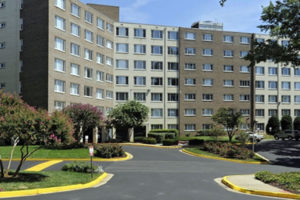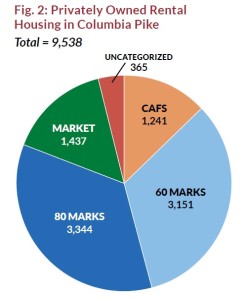A newly-formed citizens group is raising questions about the Affordable Housing Master Plan, the County’s plan to address the need for more affordable housing.
The Coalition of Arlingtonians for Responsible Development (CARD), which currently has around 70 members, is concerned with the geographic distribution of affordable housing units and the effect affordable housing has on Arlington Public Schools.
The County Board has set public hearings on the housing plan before the Board and the Planning Commission in September to allow for more public comment. The plan, as proposed, calls for the creation of 15,800 additional affordable housing units by 2040, bringing the total to 22,800 units or 17.7 percent of the total housing stock in Arlington.
For CARD, the question is not the amount of affordable housing, but where it is placed in Arlington. There are large discrepancies in where affordable housing units are located, leading to socioeconomic segregation, said Joye Murphy, a founding member of CARD.
Murphy points to neighborhoods along Columbia Pike — particularly the western end of the Pike — that feed into Randolph Elementary School. In some neighborhoods along the Pike, the county set of a target of having 15 percent of their housing available as affordable housing. However, the neighborhoods exceeded that target and have about 38 percent of its housing affordable, Murphy said.
At the same time, she said, some North Arlington neighborhoods have failed to reach their targets.
 “What we’ve seen is a disproportionate percent of affordable housing along specific areas of Arlington,” Murphy said.
“What we’ve seen is a disproportionate percent of affordable housing along specific areas of Arlington,” Murphy said.
One of CARD’s aims is to have affordable housing across the county, not just in specific sectors. By spreading affordable housing, there will be more diversity in Arlington’s neighborhoods, which will benefit all Arlington residents, said Maura McMahon, another founding member of CARD.
“CARD’s goals are for responsible development in Arlington that fosters socioeconomically diverse neighborhoods and schools so that all Arlingtonians can benefit from what Arlington has to offer: top schools, efficient transportation systems, quality recreational facilities and parks, etc.,” McMahon said. “We believe every individual and every child should be afforded an equal opportunity to achieve his/her potential.”
The current targets for the amount of affordable housing units that should exist in each neighborhood are not referenced in the new plan, Murphy said. It only lists distributing housing units throughout the county as one of its goals.
The targets allowed for accountability, said Dedra Curteman, a CARD founding member.
“The primary fault with the master plan as written is it doesn’t call for targets for geographic distribution,” Curteman said.
Without the targets for each neighborhood, affordable housing developers could theoretically place most of the new affordable housing units in specific areas of the county instead of throughout Arlington.
“I worry that the targets were deleted because they shot past the targets in many areas,” Curteman said.
CARD wants County Board members to include tools and specifics in the housing plan to ensure geographic distribution. The group plans to send a letter with their recommendations to the County in the next week, Murphy said.
The county is replacing the targets with three different ways to address affordable housing, said County Board Chair Mary Hynes.
“The plan really has three buckets that the Board would be using to achieve affordable housing,” Hynes said.
The first is preserving existing units, the second is looking at bringing affordable housing to transit corridors and the third is to look at areas with many single-family homes to see where additional housing units could be added. Hynes said that CARD is right in saying that the county does not yet have the tools needed for the second and third buckets, but after the plan is adopted she hopes the county will work on developing these tools.
The targets also did not work as the county did not have the tools to bring affordable housing to each area according to the targets, Hynes added. A lack of available land and high costs could make building affordable housing in certain parts of the county particularly difficult.
CARD members say the lack of geographic distribution affects the Arlington Public Schools, as research has shown that having a large amount of children that need reduced or free lunches influences test and achievement scores.
“Housing policy is education policy,” Murphy said.
Schools where there are high levels of affordable housing units, such as Randolph Elementary School, have seen children struggling in subjects like English and science. Murphy said that a study of Fairfax schools and housing affordability shows that when a school has 20 percent or more kids that need free or reduced lunches, such as those coming from affordable housing units, the school will have lower achievement scores regardless of the level of resources provided.
Arlington has a long history of providing resources for students in all schools, Hynes said.
“We need to figure out how we can provide good schooling everywhere, she said.
By distributing the affordable housing units across the entire county, the schools and children will perform better and students will have better opportunities, Murphy and Curteman said.
But while there are discussions happening between CARD, community members and County Board candidates, when it comes to the County Board Murphy said many of its arguments are falling on deaf ears, Murphy.
CARD sent a letter with their concerns to the County Board, and while Murphy and other CARD members had informal meetings with Board members, most of them have not formally responded. John Vihstadt is the only one who seems to be listening to them, she said.
“Joye’s group raises a number of significant questions that deserve robust airing and conversation,” Vihstadt said. “And I look forward to working with them and other community-based groups to ensure that all aspects and facets of affordable housing policy are factored in to whatever the County Board considers.”
However, Hynes said she has had many meetings with individual members of CARD. The group requested a meeting with her, but she did not have availability at the time. She referred them to her assistant, but the group has not contacted her, Hynes said.
Democratic candidate for County Board Katie Cristol has also met with CARD, and while she does not agree with them on everything, she said the group adds an important voice to the conversation. She attributes the differences between the County Board and CARD to the complexity of the housing issue.
“The issue is just the sheer complexity,” Cristol said. “It is really easy to misunderstand each other.”
Cristol agrees that there needs to be better geographic distribution for affordable housing, but it does not mean the neighborhoods have to change completely, she said.
It is important to make sure neighborhoods have diversity, instead of looking to arbitrarily make sure each has its “fair share” of affordable housing, she said. That generally aligns with CARD’s goals.
“CARD is… focused on the responsible development… to increase the quality of life for residents while promoting social and economic mobility,” the group says on its website. “Responsible development includes the thoughtful placement of geographically distributed affordable housing, educational excellence for all, shrinking the student achievement gap, and infrastructure that protects natural resources while maximizing the efficiency of transit throughout all of the county.”



